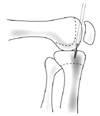Abstract
Surgical treatment for the pediatric anterior cruciate ligament (ACL) avulsion fracture consists of arthroscopic treatment and open surgery. Recently, arthroscopic treatment has been commonly performed rather than open surgery because of less post-operative pain and faster rehabilitation. In arthroscopic treatment, K-wire and cannulated cancellous screws are the main instruments used for fixation of avulsion fracture, but these instruments have the risk of causing damage to the growth plate and an additional surgery to remove the fixation is needed. In spite of the technical difficulty, the suture anchor is used to overcome the risk of damage to the growth plate and the need for an additional surgery. The authors report good results using bio-absorbable suture anchor in arthroscopic treatment for pediatric ACL avulsion fracture.
Figures and Tables
Figure 2
Preoperative magnetic resonance imaging shows avulsion fracture of the anterior cruciate ligament.

Figure 3
Arthroscopic findings show avulsion fracture of the anterior cruciate ligament and hematoma at fracture site.

Figure 4
Illustration shows the anchor insertion method by using the suprapatellar portal. The trocar is inserted under the patella through the suprapatellar portal, then the patella is lifted while the knee joint is flexed. This makes it possible to approach the area 1-2 mm anterior to the tibial attachment site of the anterior cruciate ligament (ACL), and the suture anchor can be inserted perpendicular to the articular surface. Then, the ACL is fixed with the suture.

Figure 5
Arthroscopic findings show accurate fixation of avulsion fracture of the anterior cruciate ligament with a suture anchor.

References
1. Wiley JJ, Baxter MP. Tibial spine fractures in children. Clin Orthop Relat Res. 1990. (255):54–60.

2. Ahn JH, Yoo JC. Clinical outcome of arthroscopic reduction and suture for displaced acute and chronic tibial spine fractures. Knee Surg Sports Traumatol Arthrosc. 2005. 13:116–121.

3. Uggen C, Wei A, Glousman RE, et al. Biomechanical comparison of knotless anchor repair versus simple suture repair for type II SLAP lesions. Arthroscopy. 2009. 25:1085–1092.

4. Seon JK, Park SJ, Lee KB, et al. A clinical comparison of screw and suture fixation of anterior cruciate ligament tibial avulsion fractures. Am J Sports Med. 2009. 37:2334–2339.

5. Meyers MH, McKeever FM. Fracture of the intercondylar eminence of the tibia. J Bone Joint Surg Am. 1970. 52:1677–1684.

6. McLennan JG. The role of arthroscopic surgery in the treatment of fractures of the intercondylar eminence of the tibia. J Bone Joint Surg Br. 1982. 64:477–480.

7. Veselko M, Senekovic V, Tonin M. Simple and safe arthroscopic placement and removal of cannulated screw and washer for fixation of tibial avulsion fracture of the anterior cruciate ligament. Arthroscopy. 1996. 12:259–262.

8. Tsukada H, Ishibashi Y, Tsuda E, Hiraga Y, Toh S. A biomechanical comparison of repair techniques for anterior cruciate ligament tibial avulsion fracture under cyclic loading. Arthroscopy. 2005. 21:1197–1201.





 PDF
PDF ePub
ePub Citation
Citation Print
Print





 XML Download
XML Download